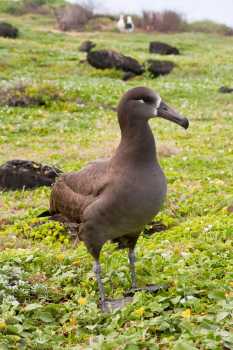Following the listing of the Black-footed Albatross Phoebastria nigripes by the Albatross and Petrel Agreement in 2009 the Sixth Meeting of the ACAP Advisory Committee meeting held in 2011 recommended that the ACAP Taxonomy Working Group (TWG) ‘should consider whether populations of Black-footed Albatrosses nesting in Japan and Hawaii are separate biological units (subspecies).’

Black-footed Albatross. Photograph by Lindsay Young
In its report to this year's Advisory Committee meeting (AC7 Doc. 13) the TWG concluded that:
“Although genetic data suggest strong population genetic differentiation between the Japanese and Hawaiian Island colonies of Black-footed Albatross it is our view there is insufficient information to support any taxonomic revision of Black-footed Albatrosses even at the subspecific level. Indeed the genetic differentiation revealed by the studies summarised above could have been elevated by the severe and recent population bottlenecks in the Japanese colonies (from intense feather collecting) thus it would be premature to act on these data alone. Further genetic and morphological studies are required before a taxonomic amendment could be justified.”
Because of this decision the Taxonomy Working Group concluded that the available information did not warrant an amendment to the species currently listed under Annex 1 of the ACAP Agreement.
Selected References:
Eda, M., Kawakami, K., Chiba, H., Suzuki, H., Horikoshi, K. & Koike, H. 2008. Genetic characteristics of the Black-footed Albatross Diomedea nigripes on the Bonin Islands and their implications for the species' demographic history and population structure. Ornithological Science 7:109-116.
Walsh, H.E. & Edwards, S.V. 2005. Conservation genetics and Pacific fisheries bycatch: mitochondrial differentiation and population assignment in black-footed albatrosses (Phoebastria nigripes). Conservation Genetics 6: 289-295.
John Cooper, ACAP Information Officer, 27 May 2013

 English
English  Français
Français  Español
Español